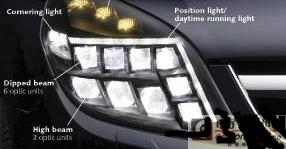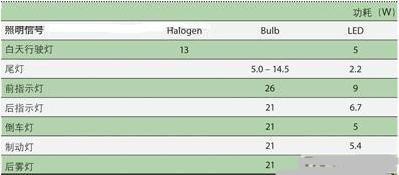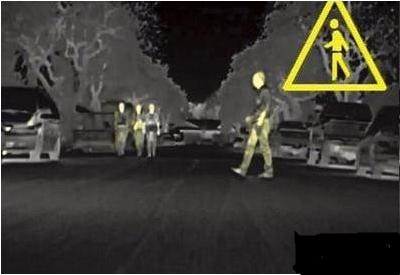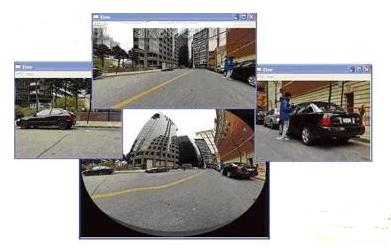From LED headlights, night vision security systems, to emerging laser ignition systems, photonics technology is gaining traction in automotive applications with its compactness, low power consumption and high performance.
This article refers to the address: http://
Optics and photonics technologies are now providing automakers with an increasingly rich “toolkit†that helps automakers improve vehicle safety, reduce long-term costs, increase efficiency, and add unique design elements to their vehicles. In addition to the common LED taillights, some cars are also trying LED headlights. At the same time, fiber optics are also being used to connect communication and display devices in automobiles. It is reported that Ford is currently investigating automotive laser ignition systems, while other high-end vehicles will also provide night vision systems and driver assistance systems.
LED tail light and headlight
“Although the cost of using LED solutions for automotive taillights and interior lighting is still much higher than the cost of incandescent lamps, the huge advantage of LED solutions is enough to enable automakers to accept higher costs in development and manufacturing. Professor Cornelius Neumann, who specializes in automotive lighting at the University of Karlsruhe in Germany, said, "In addition to its long service life (which usually lasts longer than the life of the car), its fast response time is also a brake light. An important safety factor, LED response time is usually about 75 milliseconds shorter than that of commonly used bulbs. In addition, the low power consumption of LEDs and novel shapes are also the main reasons why manufacturers choose LEDs for automotive signals.
Professor Neumann and Hella, a German automotive lighting and electronics supplier, have conducted in-depth research in the field of automotive lighting for 11 years. He said that although LED taillights are more common in automobiles, the use of LED headlights in automobiles is facing more challenges.
“So far, there are at least three models on the market that use LED headlights: the Lexus LS 600, the Audi R8 and the Cadillac Escalade Platinum,†said Professor Neumann. “But the LED solution is completely used in the headlights. Many problems need to be solved."
Professor Neumann pointed out that dust, humidity, mechanical vibration and harsh environments with an ambient temperature of up to 90 °C will pose certain challenges to LEDs, as the performance of LEDs will decrease with increasing temperature, so some high-power LEDs are required to be equipped with a cooling device. Moreover, LED headlamps do not use a single light source (such as a halogen lamp or a high-intensity discharge (HID) lamp), but rather assemble multiple LEDs together to meet the needs of driving signal illumination. [1] In LED headlights, three different optical systems are typically used to achieve different functions. These three systems need to be firmly matched to each other to emit light of sufficient brightness to meet the requirements of road-going lighting.
Although LED headlamps still face many challenges, Professor Neumann adds that LED solutions can save 50% or more of energy compared to common bulb solutions (see Table 1). [2] According to some studies, less than 20% of LED light can achieve the same brightness as HID lamps, and LED lighting is safer. [3] With the development of mathematical models and software algorithms, engineers can now design and produce various forms of mirrors and lenses that direct light from the source to specific areas of the traffic surface (see Figure 1).

Figure 1: Opel Signum's headlights all use LED solutions, which use different modules to achieve different signal functions: 6 sets of LEDs for low beam; bottom 3 sets of LEDs for high beam; Small LEDs are used for corner lights; 10 groups of LEDs are used for daytime running lights. The direction indicator light consists of three sets of LEDs with a reflective system located on top of the headlights. Different LEDs are used depending on the application of each signal.
Table 1: Comparison of traditional lighting methods and LED lighting power consumption

High-brightness LED manufacturers have good reason to believe that LEDs will penetrate into the automotive field in the future. Market research firm Strategies Unlimited predicts that by 2013, the overall market size of global automotive LED outdoor lighting will increase from $158 million in 2008 to $347 million. According to ResearchInChina's "2008-2009 Global and China Automotive LED Lighting Industry Research Report", by 2014, LED headlights will be compared with traditional HID headlights in terms of cost and performance (assuming LED The technology can be improved according to the current development speed. It will be comparable. At that time, the application of LED in the automotive field will be greatly improved. The market size of the car headlight alone will reach 122 million US dollars.
BMW's BMW-7 series uses the second-generation Night Vision 2 night vision system from Autoliv, Sweden, which uses a far-infrared sensor to scan pedestrians on the road, with a night vision distance three times that of a low beam. . When a pedestrian or animal is detected in front of the vehicle, the system automatically analyzes the site and vehicle dynamics, assesses the risk of the driver colliding with the target, and alerts the driver if necessary (eg, via the on-board display, see Figure 2). ). "Autoliv's latest night vision system takes night driving safety to a whole new level, giving drivers the 'another eye' on the night road," said Stuart Klapper, general manager of night vision systems at Autoliv.

Figure 2: The far-infrared night vision system of the BMW BMW-7 series car alerts the driver when a man is detected crossing the road at night.
In urban sections with slower speeds and more people, the system only monitors the smaller range within the close distance of the road to avoid excessive alarms; in rural sections with high speed and few people, The road range monitored by the system will be expanded accordingly. In order to make timely and corresponding adjustments to the monitoring range, Autoliv's night vision system continuously collects night vision video images from the surrounding environment and uses more than 50 million "video clips" to detect with a set of advanced software algorithms. And accordingly, the corresponding warning signal is sent to the driver.
The far-infrared camera used in Autoliv's night vision system uses a 320 x 240 pixel vanadium oxide thermal radiation meter and has a dome window to protect the camera's lens from the outside world. Klapper said: "Compared with the first generation of cameras, we have now successfully reduced the cost of the lens by as much as 30%."
Siemens VDO has also developed an infrared night vision system with a working distance of up to 150 meters, which produces an electronically processed video image for real-time display in the car. The system works in two ways: one uses a near-infrared system, in which the light produced by two infrared emitters integrated into the headlights is captured by a small camera mounted near the rearview mirror. Another way is to use a long-wave infrared system, which requires a camera to be used to detect thermal radiation from the surrounding environment of the vehicle with a sensor operating in the range of 6 to 12 μm. Once a person or animal is detected, the system displays the object in a bright form.
Laser ignition
In the summer of 2009, Ford announced that it is working with GSI Group and the University of Liverpool to develop a laser ignition system for the next generation of automotive engines. In fact, as early as the end of the 1970s, people began to study laser ignition systems. At that time, many research papers on laser ignition systems began to appear in various automotive technology conferences.
Because the laser can be broken down into multiple beams, multiple ignition points will increase the chance of complete combustion of the fuel in the engine, thereby reducing emissions and improving fuel combustion efficiency in cold and humid conditions. Even a portion of the laser energy can be emitted back to provide information about how the engine is operating, so that the air/fuel mixture ratio is automatically adjusted for better fuel efficiency. Ford also said it plans to provide laser sparks through a fiber optic cable, which would take up less space than a spark plug, allowing for larger, more efficient engine valves for more fuel burn.
In 2007, researchers at the National Energy Technology Laboratory () have designed a laser ignition system that is integrated with an internal combustion engine. The system produces a firing spark by a 10 ns pulse from a 1.06 μm laser that is focused into the cylinder through a spark plug port. Compared with traditional single-cylinder, four-stroke, spark-ignition engines, the use of laser spark ignition systems not only reduces engine emissions, but also improves fuel combustion efficiency.
Driver assistance system
In addition to lighting and night vision applications, driver assistance systems based on photonics technology are currently available. The Landao of Valeo and the BMW-5 series of BMW are equipped with driver assistance systems. The entire system consists of five cameras: a wide-angle camera mounted on the rear of the car for parking assistance; two cameras mounted on the left and right sides of the front bumper to assist the driver when the vehicle enters a less visible street Observe pedestrians or other objects close to the vehicle; two other cameras mounted on the two side mirrors for direct monitoring of the environment around the vehicle.
Panomorph technology is a patented wide-angle lens technology from ImmerVision Canada that increases the angular resolution in a particular area of ​​an image field of view, placing the target area of ​​interest at the center or edge of the image (see Figure 3). [4] There are also specific windows for the driver to observe, and other synchronized visual images can be used for road analysis, for example, through an intelligent cruise control system that enables collision avoidance systems, blind spot viewing, pedestrian and road sign detection, and Many applications such as lane tracking are integrated.

Figure 3: Multiple synchronized non-distorted images from a Panomorph camera that can assist in driving, such as helping the driver avoid collisions and assisted parking.
Alain Marchildon, vice president of custom panorama applications at ImmerVision, said: "Samsung has signed a production and distribution license agreement with ImmerVision, and its first Automotive Tier 2 will offer a Panomorph automotive vision module. 360° panoramic vision system A new enhanced panoramic viewing and sensing application can be implemented to significantly reduce collision-related casualties and provide a safer driving environment for drivers and passengers."
EDM (electrical discharge machining), is a manufacturing process used to obtain a specific desired shape in metal by applying electrical discharges(sparks),When it comes to using electrical discharge machining, the water serves as a key component. To get the best performance from an Edm Machine, the water must be kept as clean as possible. During the EDM process, some of the metal goes into the water as small particles. The water is filtered and deionized(demineralized) in order to remove those metal atoms. Deionized water helps to promote a higher metal removal rate and enhances the machine`s capacity to deliver a more precise cut. So the EDM water filter is very important component for EDM water filtration system.
Edm Filter,Edm Machine,Edm Machining,Wire Edm Machine
Donguan Bronco Filter Co., Ltd , https://www.broncofilter-cn.com